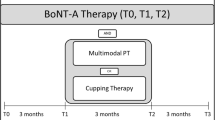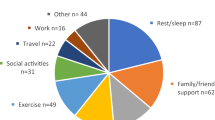Abstract
Cervical dystonia is a form of adult-onset, focal dystonia characterized by involuntary contractions of the neck muscles, leading to a disabling, abnormal head posture. CD has a great impact on the activities of daily living (ADL) and quality of life. Currently, the most widely used and recommended first line treatment is botulinum toxin type A (BoNT/A) injections. Physiotherapy is a potentially useful adjuvant, but little is known about its effectiveness. Consequently, our objective was to investigate the effectiveness of physiotherapy alone or as an adjuvant treatment to BoNT/A injections in cervical dystonia (CD) by means of a systematic literature review. Two online databases, PubMed and Web of Science, were searched for articles describing the effectiveness of physiotherapy treatment for CD. After screening, based on predefined in- and exclusion criteria, 16 studies were retained. Their methodological quality was assessed according to Cochrane guidelines. The methodological quality of most studies was low. Examples of shortcomings are small sample sizes, lack of randomization or blinding, and diversity in therapeutic techniques and outcome measures. Only seven studies were clinical trials; the remaining were either case reports or case series. The reported physiotherapy treatments included EMG biofeedback training, muscular elongation, postural exercises and electrotherapy. Improvements in head position, pain, cervical range of motion, quality of life and ADL have been reported, which is promising. Cautious interpretation on the effectiveness of physiotherapy as an adjuvant therapy is required. Before firm conclusions can be drawn, additional high quality trials are needed.

Similar content being viewed by others
References
Berardelli A, Rothwell JC, Hallett M et al (1998) The pathophysiology of primary dystonia. Brain 121(Pt 7):1195–1212
Jinnah HA, Berardelli A, Comella C et al (2013) The focal dystonias: current views and challenges for future research. Mov Disord 28:926–943. doi:10.1002/mds.25567
Warner T, Camfield L, Marsden CD, Collaborative T, Epidemiological S of D in E (ESDE) et al (2000) A prevalence study of primary dystonia in eight European countries. J Neurol 247:787–792
Jankovic J, Tsui J, Bergeron C (2007) Prevalence of cervical dystonia and spasmodic torticollis in the United States general population. Parkinsonism Relat Disord 13:411–416. doi:10.1016/j.parkreldis.2007.02.005
Stacy M (1982) Epidemiology, clinical presentation, and diagnosis of cervical dystonia. Neurol Clin Suppl1:23–42
Fukuda H, Kusumi M, Nakashima K (2006) Epidemiology of primary focal dystonias in the western area of Tottori prefecture in Japan: comparison with prevalence evaluated in 1993. Mov Disord 21:1503–1506. doi:10.1002/mds.20986
Albanese A, Asmus F, Bhatia KP et al (2011) EFNS guidelines on diagnosis and treatment of primary dystonias. Eur J Neurol 18:5–18. doi:10.1111/j.1468-1331.2010.03042.x
Zetterberg L, Aquilonius S-M, Lindmark B (2009) Impact of dystonia on quality of life and health in a Swedish population. Acta Neurol Scand 119:376–382. doi:10.1111/j.1600-0404.2008.01111.x
Trotti LM, Esper CD, Feustel PJ et al (2009) Excessive daytime sleepiness in cervical dystonia. Parkinsonism Relat Disord 15:784–786. doi:10.1016/j.parkreldis.2009.04.007
Martikainen KK, Luukkaala TH, Marttila RJ (2010) Working capacity and cervical dystonia. Parkinsonism Relat Disord 16:215–217. doi:10.1016/j.parkreldis.2009.07.006
Avanzino L, Martino D, Marchese R et al (2010) Quality of sleep in primary focal dystonia: a case-control study. Eur J Neurol 17:576–581. doi:10.1111/j.1468-1331.2009.02884.x
Molho ES, Agarwal N, Regan K, Higgings DS, Factor SA (2009) Effect of cervical dystonia on employment: a retrospective analysis of the ability of treatment to restore premorbide employment status. Mov Disord 24:1384–1387. doi:10.1002/mds.22574
Müller J, Kemmler G, Wissel J et al (2002) The impact of blepharospasm and cervical dystonia on health-related quality of life and depression. J Neurol 249:842–846. doi:10.1007/s00415-002-0733-1
Gündel H, Wolf A, Xidara V et al (2001) Social phobia in spasmodic torticollis. J Neurol Neurosurg Psychiatry 71:499–504
Fabbrini G, Berardelli I, Moretti G et al (2010) Psychiatric disorders in adult-onset focal dystonia: a case-control study. Mov Disord 25:459–465. doi:10.1002/mds.22983
Albanese A, Barnes MP, Bhatia KP et al (2006) A systematic review on the diagnosis and treatment of primary (idiopathic) dystonia and dystonia plus syndromes: report of an EFNS/MDS-ES Task Force. Eur J Neurol 13:433–444. doi:10.1111/j.1468-1331.2006.01537.x
Phukan J, Albanese A, Gasser T, Warner T (2011) Primary dystonia and dystonia-plus syndromes: clinical characteristics, diagnosis, and pathogenesis. Lancet Neurol 10:1074–1085. doi:10.1016/S1474-4422(11)70232-0
Velickovic M, Benabou R, Brin MF (2001) Cervical dystonia pathophysiology and treatment options. Drugs 61:1921–1943
Martino D, Liuzzi D, Macerollo A et al (2010) The phenomenology of the geste antagoniste in primary blepharospasm and cervical dystonia. Mov Disord 25:407–412. doi:10.1002/mds.23011
Camfield L, Ben-Shlomo Y, Warner T, ESDE (2002) Impact of cervical dystonia on quality of life. Mov Disord 17:838–841. doi:10.1002/mds.10187
Pekmezovic T, Svetel M, Ivanovic N et al (2009) Quality of life in patients with focal dystonia. Clin Neurol Neurosurg 111:161–164. doi:10.1016/j.clineuro.2008.09.023
Soeder A, Kluger BM, Okun MS et al (2009) Mood and energy determinants of quality of life in dystonia. J Neurol 256:996–1001. doi:10.1007/s00415-009-5060-3
Skogseid IM, Malt UF, Røislien J, Kerty E (2007) Determinants and status of quality of life after long-term botulinum toxin therapy for cervical dystonia. Eur J Neurol 14:1129–1137. doi:10.1111/j.1468-1331.2007.01922.x
Ben-Shlomo Y, Camfield L, Warner T (2002) What are the determinants of quality of life in people with cervical dystonia? J Neurol Neurosurg Psychiatry 72:608–614
Delnooz CCS, Horstink MWIM, Tijssen MA, van de Warrenburg BPC (2009) Paramedical treatment in primary dystonia: a systematic review. Mov Disord 24:2187–2198. doi:10.1002/mds.22608
Liberati A, Altman DG, Tetzlaff J et al (2009) The PRISMA statement for reporting systematic reviews and meta-analyses of studies that evaluate health care interventions: explanation and elaboration. PLoS Med 6:e1000100. doi:10.1371/journal.pmed.1000100
Schünermann HJ, Oxman AD, Vist GE, Higgins JPT, Deeks JJ, Glasziou GG (2011) Chapter 12: Interpreting results and drawing conclusions. Cochrane Handb. Syst. Rev. Interv. Version 5.1.0
Postma M, Zoons E, Speelman J, de Koning-Tijssen M (2012) (Botuline) Behandel richtlijn voor Cervicale dystonie. 1–90
Leplow B (1990) Heterogenity of biofeedback training effects in spasmodic torticollis: a single-case approach. Behav Res Ther 4:359–365
Jahanshahi M, Sartory G, Marsden CD (1991) EMG biofeedback treatment of torticollis: a controlled outcome study. Biofeedback Self Regul 16:413–448
Smania N, Corato E, Tinazzi M et al (2003) The effect of two different rehabilitation treatments in cervical dystonia: preliminary results in four patients. Funct Neurol 18:219–225
Tassorelli C, Mancini F, Balloni L et al (2006) Botulinum toxin and neuromotor rehabilitation: an integrated approach to idiopathic cervical dystonia. Mov Disord 21:2240–2243. doi:10.1002/mds.21145
Duddy J, McLellan D (1995) Lack of influence of EMG biofeedback in relaxation training for spasmodic torticollis. Clin Rehabil 9:297–303. doi:10.1177/026921559500900404
John Spencer, Goetsch Virginia L, Brugnoli Robert J, Herman S (1991) Behavior therapy for spasmodic torticollis: a case study suggesting a causal role for anxiety. J Behav Ther Exp Psychiatry 22:305–311
Ramdharry G (2006) Case report: physiotherapy cuts the dose of botulinum toxin. Physiother Res Int 11:117–122. doi:10.1002/pri
Zetterberg L, Halvorsen K, Färnstrand C et al (2008) Physiotherapy in cervical dystonia: six experimental single-case studies. Physiother Theory Pract 24:275–290. doi:10.1080/09593980701884816
El-bahrawy MN, El-tamawy MS, Shalaby NM, Abdel-alim AM (2009) Cervical Dystonia : abnormal head posture and its relation to hand function. Egypt J Neurol Psychiatry Neurosurg 46:203–208
Queiroz MAR, Chien HF, Sekeff-sallem FA, Barbosa ER (2012) Physical therapy program for cervical dystonia: a study of 20 cases. Funct Neurol 27:187–192
Boyce MJ, Canning CG, Mahant N et al (2013) Active exercise for individuals with cervical dystonia: a pilot randomized controlled trial. Clin Rehabil 27:226–235. doi:10.1177/0269215512456221
Bleton JP (1994) Spasmodic torticollis. In: Handbook of rehabilitative physiotherapy. Editions Frison-Roche, Paris
Albanese A, Del Sorbo F, Comella C et al (2013) Dystonia rating scales: critique and recommendations. Mov Disord 28:874–883. doi:10.1002/mds.25579
Acknowledgments
We would like to thank Birgit Daalderop for helping with the data collection.
Funding
University of Antwerp (BDHG/3449/18.12.202).
Conflicts of interest
On behalf of all authors, the corresponding author states that there is no conflict of interest.
Author information
Authors and Affiliations
Corresponding author
Rights and permissions
About this article
Cite this article
De Pauw, J., Van der Velden, K., Meirte, J. et al. The effectiveness of physiotherapy for cervical dystonia: a systematic literature review. J Neurol 261, 1857–1865 (2014). https://doi.org/10.1007/s00415-013-7220-8
Received:
Accepted:
Published:
Issue Date:
DOI: https://doi.org/10.1007/s00415-013-7220-8




